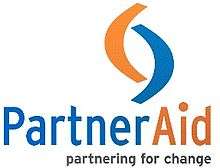PartnerAid
PartnerAid is a German-based non-denominational Christian humanitarian organization with the vision that every human in the world should have access to key resources which enable them to live free from poverty.
PartnerAid’s mission is to work with people and communities in less developed countries, helping them to combat poverty and improve their living conditions. The main focus of its work concentrates on 3 thematic areas: Development-oriented Emergency Aid; Health, Water & Nutrition and Education & Livelihood.
The International Office is located in Neu-Anspach, near Frankfurt with sister organizations in Netherlands, Switzerland, the United Kingdom and the United States.

Working principles
PartnerAid believes all people are created equal and that each person deserves to be treated with love and respect. PartnerAid values people of every culture, race, gender, faith, sexuality, class, age and political viewpoint and recognises the importance of cultural diversity. PartnerAid believes that it one can only effectively enter into true partnerships with others if partners treat each other as equals.[1]
PartnerAid is a signatory to the Code of Conduct for ICRC, The International Red Cross and Red Crescent Movement and NGOs in Disaster Relief, a set of basic professional principles which set standards for good practice in disaster relief.[2]
History

PartnerAid was first established in 1998 by a group of Christians determined to make an active contribution, and providing aid and assistance voluntarily, to overcome suffering and poverty in the countries of Central and South Asia. In 2014, its name changed to World Relief Deutschland after partnering with world relief.
Due to increasing numbers of new and ongoing crises and disasters globally, the demand for the humanitarian assistance provided by PartnerAid has increased. Consequently, PartnerAid has been undergoing administrative and operational changes in order to meet those needs.
To date PartnerAid has implemented activities in more than 15 countries in Asia and Africa and is currently operational in Ethiopia, Indonesia, Kyrgyzstan, Pakistan, Somalia, Sudan, Tajikistan, Tanzania and Yemen.[3] The number of beneficiaries from activities in PartnerAid’s 5 main project locations in 2011 totaled 219.911, with an expenditure totaling €2,195,192.00.[4]
Areas of Priority
PartnerAid’s mission, as an expression of its values of Integrity, Equality and Relationship, is to partner with people of disadvantaged communities through relief and development assistance, in the 3 Major Focus areas as established in 2007:
Development-oriented Emergency Aid
PartnerAid aims to alleviate the suffering of people from the consequences of disasters without creating dependency, seeking instead to empower people and give them the opportunity to lead dignified lives after the crises and disasters.
Health, Water & Nutrition
PartnerAid assists people in disaster and conflict areas with Primary Health Care initiatives such as health promotion and disease prevention, maternal and child health care, sustainable emergency care, immunization, nutrition and securing clean safe drinking water.
Education & Livelihoods
PartnerAid aims to provide community access to school education and skills training. Closely linked to this are measures to enable people to find a way out of poverty through a sustainable income by promoting small enterprises, training and consulting, small loans and infrastructure support.
There is strong organizational emphasis on improving awareness and understanding of the culture and language of the host communities, in an effort to target poverty holistically and with greater sustainability. As such, PartnerAid considers integral to the success of its activities, the language and cultural expertise of its international staff.[5]
Funding

PartnerAid’s work is funded through subsidies and donations from private individuals as well as institutions. (See chart)
89.1% of this total revenue in 2011 was for operational spending and the remaining 10.9% for general administration.[6]
Organizational structure

PAI - PartnerAid International e.V. is a registered association recognized as a charity in Germany.
Additionally four sister organizations - PartnerAid UK, PartnerAid US, PartnerAid NL, PartnerAid Switzerland - are registered in their respective countries as legally and financially independent entities. However, a common agreement exists to provide a basis for cooperation and division of labour.
The organizational structure of the association is composed of the General Assembly of Members, the Executive Board and the Supervisory Board. Operational field programmes are directly responsible to the Executive Board but are supported by the operations department of the International Office.
The staff members of PartnerAid are either employed staff members or work on a voluntary basis in the International Office or are directly involved in the projects.[7]
Affiliation
- EPN Hessen – Entwicklungspolitisches Netzwerk Hessen (Hessen Development Policy Network)
- Deutsch-Jemenitische Gesellschaft (German - Yemeni Society)
- Erlassjahr.de (association of German development policy organizations).[8]
Partners
UN Partner
- IOM – International Organization for Migration
- UNDP – United Nations Development Program, Common Humanitarian Fund – Sudan
- UNFPA – United Nations Population Fund
- UNHCR – United Nations High Commissioner for Refugees
- UNICEF – United Nations Children Fund
- UNOCHA - United Nations Office for the Coordination of Humanitarian Affairs
- WFP – United Nations World Food Program
- WHO – World Health Organization
Government partners
- CIM – Centre for International Migration and Development / GIZ – German Agency for International Development
- Embassy of Japan in Yemen
- USAID / OFDA – United States Agency for International Development
Other organizations
- Aid to Leprosy Patients
- Aktion HelpDirekt e.V.
- Concern Worldwide
- Dorcas Aid International
- Food for the Hungry
- gut.org (charitable public limited company)
- Hope e.V.
- Humedica e.V.
- Millennium Relief and Development Services
- PartnerAid CH
- PartnerAid NL
- PartnerAid UK
- PartnerAid USA
- Tearfund UK.[9]
References
- ↑ Annual Report 2011 PartnerAid, page 4 http://www.partneraid.org/wp-content/uploads/2012/07/Annual-Report-Final-English-Version-12.pdf
- ↑ Annual Report 2011 PartnerAid, page 30 http://www.partneraid.org/wp-content/uploads/2012/07/Annual-Report-Final-English-Version-12.pdf
- ↑ http://www.partneraid.org/where-we-work/
- ↑ Annual Report 2011 PartnerAid, page 10, 11 http://www.partneraid.org/wp-content/uploads/2012/07/Annual-Report-Final-English-Version-12.pdf
- ↑ http://www.partneraid.org/how-we-work/
- ↑ Annual Report 2011 PartnerAid, page 24 http://www.partneraid.org/wp-content/uploads/2012/07/Annual-Report-Final-English-Version-12.pdf
- ↑ Annual Report 2011 PartnerAid, page 5 http://www.partneraid.org/wp-content/uploads/2012/07/Annual-Report-Final-English-Version-12.pdf
- ↑ Annual Report 2011 PartnerAid, page 30 http://www.partneraid.org/wp-content/uploads/2012/07/Annual-Report-Final-English-Version-12.pdf
- ↑ Annual Report 2011 PartnerAid, page 30 http://www.partneraid.org/wp-content/uploads/2012/07/Annual-Report-Final-English-Version-12.pdf